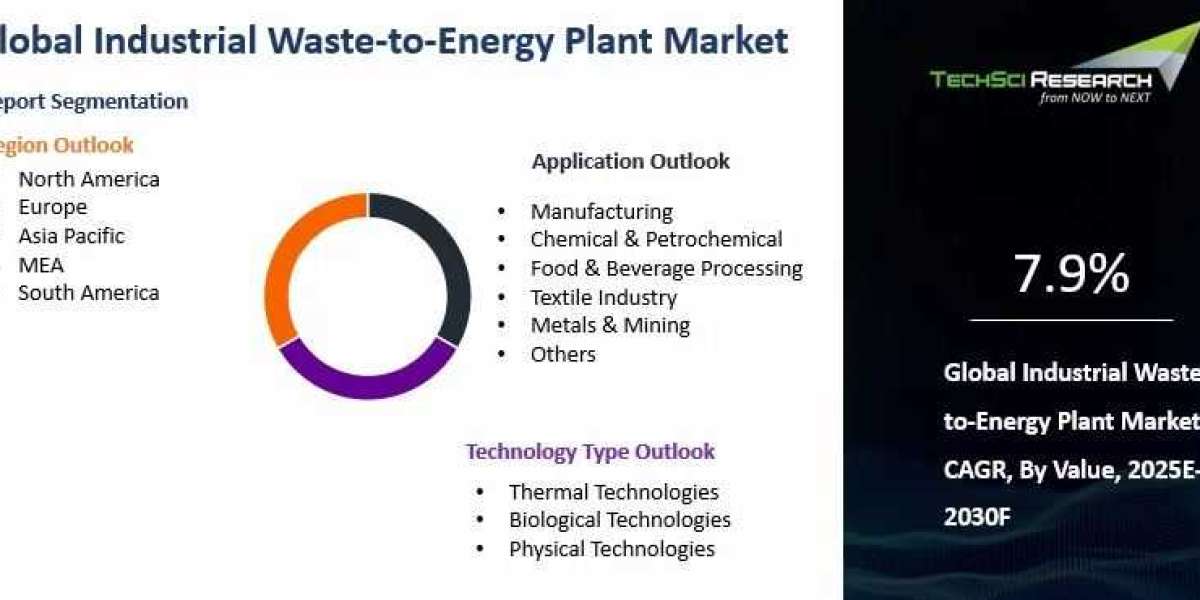According to a recent TechSci Research report, the Global Industrial Waste-to-Energy (WtE) Plant Market was valued at USD 18.4 billion in 2024 and is projected to reach USD 29.3 billion by 2030, registering a CAGR of 7.9% during the forecast period. The market’s growth is being fueled by the dual imperatives of energy security and sustainable waste management.
The depletion of fossil fuel reserves, coupled with price volatility, is compelling industries and governments to explore alternative, reliable energy sources. Waste-to-Energy technologies address this challenge by converting industrial waste into usable energy while reducing the environmental burden of landfills. The rising waste volumes from industries such as chemicals, pharmaceuticals, and food processing are further ensuring a steady feedstock supply for WtE facilities worldwide.
Key Market Drivers
Energy Security and Diversification
A major driver of the market is the global demand for energy diversification. Industrial WtE plants provide an alternative to traditional fossil fuels, ensuring more stable and localized energy supply. In regions where energy imports dominate, WtE facilities contribute to reducing dependence on foreign resources while enhancing resilience against supply chain disruptions.
Rising Industrial Waste Generation
Rapid industrialization and urban expansion have led to unprecedented levels of waste generation. Industrial sectors such as food processing, chemicals, and pharmaceuticals produce vast quantities of biodegradable and non-biodegradable waste. These materials create a reliable input stream for WtE plants, reducing pressure on landfill sites and supporting sustainable waste management systems.
Economic Benefits for Industries
WtE plants offer significant economic advantages. By reducing waste disposal costs, lowering energy bills, and generating additional revenue streams from by-products such as electricity, heat, and organic fertilizers, these facilities provide tangible financial incentives. Industrial players are increasingly integrating WtE systems into operations to capture both cost savings and sustainability benefits.
Technological Advancements
Technological innovation is transforming the operational efficiency of WtE plants. Automation, smart waste management systems, and AI-driven monitoring have enhanced plant productivity, minimized downtime, and optimized energy conversion rates. These advancements make WtE systems more viable even in remote or under-resourced regions, broadening their global adoption.
Policy Support and ESG Commitments
International organizations and financial institutions are offering grants, subsidies, and carbon credit schemes to promote WtE adoption. Simultaneously, industries are striving to improve their ESG (Environmental, Social, and Governance) scores, making WtE investments strategically attractive. Governments across developed and emerging economies are positioning WtE as a cornerstone of their sustainability agendas.
Technology Insights
Biological Technologies: Market Leader
In 2024, the biological technologies segment dominated the Industrial Waste-to-Energy Plant Market and is expected to maintain its leadership throughout the forecast period. This segment includes processes such as anaerobic digestion and composting, which convert organic industrial waste into energy-rich biogas and bio-fertilizers.
Industries generating large amounts of biodegradable waste—such as food processing, agriculture, and pharmaceuticals—are key adopters of biological WtE solutions. The appeal lies in their ability to combine waste treatment with renewable energy generation and nutrient recovery, thereby advancing circular economy principles.
Advantages Over Thermal Methods
Unlike thermal methods such as incineration, biological technologies have a lower environmental footprint. They emit fewer greenhouse gases, avoid high-temperature combustion, and align with stringent environmental regulations, particularly in the European Union and North America. Governments are promoting anaerobic digestion through subsidies, tax incentives, and regulatory mandates, accelerating adoption rates.
Contribution to Circular Economy
Biological processes not only recover energy but also produce nutrient-rich digestate that can be used as an organic fertilizer. This dual output enhances resource efficiency and supports corporate sustainability goals. By integrating biological WtE systems directly into industrial operations, companies achieve both environmental compliance and cost-effectiveness.
Technological Innovations
Recent advancements in bioreactor design, microbial optimization, and automated process controls have greatly improved the efficiency and scalability of biological systems. With higher energy yields and reduced downtime, industries in both developed and developing markets are adopting these solutions at a faster pace.
Decentralized Energy Systems
The global shift toward decentralized energy production is boosting the demand for on-site WtE plants. Mid-sized and large enterprises are increasingly installing anaerobic digestion units to generate their own energy, reduce waste transport costs, and minimize carbon emissions, creating a self-reliant and sustainable energy ecosystem.
Browse over XX market data Figures spread through XX Pages and an in-depth TOC on the "Global Industrial Waste-to-Energy Plant Market"
https://www.techsciresearch.com/report/industrial-waste-to-energy-plant-market/29804.html
Regional Insights
Asia Pacific: Fastest-Growing Market
Asia Pacific is emerging as the fastest-growing region in the Industrial Waste-to-Energy Plant Market. Industrialization, rising waste volumes, and limited landfill capacity are intensifying demand for sustainable waste solutions.
China: Emphasizing clean energy development under its 14th Five-Year Plan, with WtE as a key priority.
India: Allocating significant funding through its National Clean Energy Program to support new WtE facilities.
Japan and South Korea: Investing heavily in advanced WtE systems to manage industrial and municipal waste sustainably.
Governments across the region are supporting projects with public-private partnerships, policy incentives, and financial subsidies, creating a favorable environment for both domestic and international investors.
North America: Established Leader
North America continues to be a global leader due to strong regulatory support, advanced technologies, and corporate sustainability commitments. The region’s mature energy infrastructure and emphasis on GHG reduction are driving significant investments in both thermal and biological WtE technologies.
Europe: Policy-Driven Expansion
Europe benefits from stringent environmental regulations and a strong push toward circular economy practices. The European Union’s waste directives and decarbonization targets are encouraging industries to adopt WtE solutions. The focus is especially strong on biological methods due to their compliance with EU emissions standards.
Emerging Regions
Latin America: Gaining momentum in WtE projects, particularly in urban centers dealing with industrial waste challenges.
Middle East Africa: Beginning to invest in WtE technologies as part of diversification and renewable energy strategies, although growth remains at an early stage.
Competitive Landscape
The competitive environment is characterized by collaborations between technology providers, environmental engineering firms, and waste management specialists. Key players are focusing on:
Expanding capabilities in biological and thermal WtE systems.
Offering AI-enabled monitoring and automation solutions to improve efficiency.
Forming strategic alliances for regional expansion, particularly in Asia Pacific.
Leveraging carbon credits and long-term service contracts to ensure profitability.
Innovation, regulatory compliance, and scalability remain the core differentiators for success in this evolving market.
Conclusion
The Global Industrial Waste-to-Energy Plant Market is poised for robust growth, driven by the pressing need for energy diversification, rising industrial waste volumes, and sustainability imperatives. With biological technologies leading the way, supported by advances in automation and microbial engineering, WtE systems are becoming central to industrial waste management strategies.
Asia Pacific stands out as the fastest-growing region, supported by government initiatives and rising environmental awareness. Meanwhile, North America and Europe remain critical hubs for technological innovation and regulatory-driven adoption.
As industries strive to meet ESG targets and circular economy goals, WtE plants represent not only a waste management solution but also a strategic energy investment for the future.
Key market players in the Industrial Waste-to-Energy Plant Market are:
Veolia Environnement S.A.
Suez S.A.
Covanta Holding Corporation
Babcock Wilcox Enterprises, Inc.
Hitachi Zosen Inova AG
Mitsubishi Heavy Industries, Ltd.
Wheelabrator Technologies Inc.
China Everbright Environment Group Limited
Download Free Sample Report
https://www.techsciresearch.com/sample-report.aspx?cid=29804
Customers can also request for 10% free customization on this report.
“The global Industrial Waste-to-Energy (WtE) Plant Market presents significant growth opportunities driven by increasing industrial waste volumes and the global push for sustainable energy solutions. Rising environmental concerns, stricter waste disposal regulations, and the need for alternative energy sources are encouraging industries to adopt WtE technologies. Opportunities also lie in technological advancements, such as improved anaerobic digestion and gasification systems, which enhance efficiency and reduce emissions.
Emerging economies in Asia Pacific, Latin America, and Africa offer untapped potential due to growing industrialization and supportive government initiatives. Additionally, circular economy initiatives and carbon neutrality goals further strengthen market prospects globally.” said Mr. Karan Chechi, Research Director of TechSci Research, a research-based global management consulting firm.
“Industrial Waste-to-Energy Plant Market – Global Industry Size, Share, Trends, Opportunity, and Forecast, Segmented By Technology Type (Thermal Technologies, Biological Technologies, Physical Technologies), By Application (Manufacturing, Chemical Petrochemical, Food Beverage Processing, Textile Industry, Metals Mining, Others), By Region, By Competition, 2020-2030F” has evaluated the future growth potential of Industrial Waste-to-Energy Plant Market and provides statistics information on market size, structure, and future market growth. The report intends to provide cutting-edge market intelligence and help decision makers take sound investment decisions. Besides the report also identifies and analyzes the emerging trends along with essential drivers, challenges, and opportunities in Industrial Waste-to-Energy Plant Market.
Contact
TechSci Research LLC
420 Lexington Avenue,
Suite 300, New York,
United States- 10170
M: +13322586602
Email: sales@techsciresearch.com
Website: https://www.techsciresearch.com







